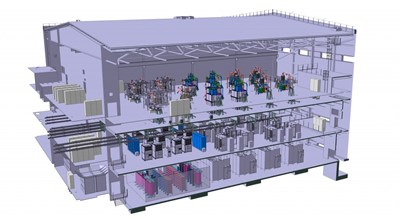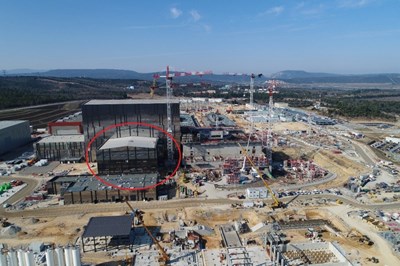
Power supplies, wave-generating gyrotrons, transmission lines—the Radio Frequency Heating Building will house the equipment for the electron cyclotron heating system.
Abutting one wall of the Assembly Hall is a three-storey structure that that was originally designed to house the equipment required to generate the high-frequency electromagnetic waves of ITER's electron and
ion cyclotron heating systems.
As a result of ITER's proposed updated baseline and research plan, plans for the building have been modified to exclusively house electron cyclotron heating systems, and a building will be added to house ion cyclotron equipment.
Both systems are radiowave-generating systems that are designed to deliver energy at frequencies that match the oscillations of particles inside the plasma—a matching called "resonance." The energy increases the velocity of the particles' chaotic motion, and at the same time their temperature.
Without the ITER heating systems to start and maintain the fusion reactions, there could be no fusion power in ITER. The scientific program will rely on radio-wave external heating systems to provide up to 87 MW of input heating power (up to 67 MW for ECRH and up to 20 MW for ICRH). A third external heating system, neutral beam injection, will provide another 33 MW of input heating power.
In electron cyclotron resonance heating (ECRH),
electrons are targeted at a resonant frequency of 170 GHz. In ion cyclotron resonance heating (ICRH), energy is transferred to the
ions in the plasma by a high-intensity beam of electromagnetic radiation with a frequency chosen between 40 to 55 MHz. Both heating systems are based on the same principle—the conversion of electrical power into electromagnetic radiation—however, the technology they rely upon is considerably different.

The Radio Frequency Heating Building shares one wall with the Assembly Building.
The ECRH system transmits heat to the plasma through microwaves, much in the same way a microwave oven heats food. The ICRH source is more aptly compared to a powerful radio transmitter of the kind that is still used to broadcast information from one end of the world to the other—with the difference that the ITER system will require a number of amplifiers to reach a much higher level of power.
The Radiofrequency Building will house the power supplies and wave generators (gyrotrons) for electron cyclotron resonance heating. Waves generated by the gyrotrons will travel along robust transmission lines through the Assembly Building and into the Tokamak Building, where ECRH launchers will deliver their energy deep into the plasma.
Plans are underway for a modified building and transmission-line route for ion cyclotron resonance heating.
Radio Frequency Building facts:
- Construction: 2016-2022
- Building dimensions: height 25 m, length (east/west) 50 m, width (north/south) 43 m
- Number of storeys: 3
- Electron cyclotron (ECRH) equipment housed: power supplies, wave-generating gyrotrons, and transmission lines
- Update 2024: A separate building will be constructed to house ion cyclotron (ICRH) power supplies, radiofrequency transmitters, and transmission lines






.jpg)













































